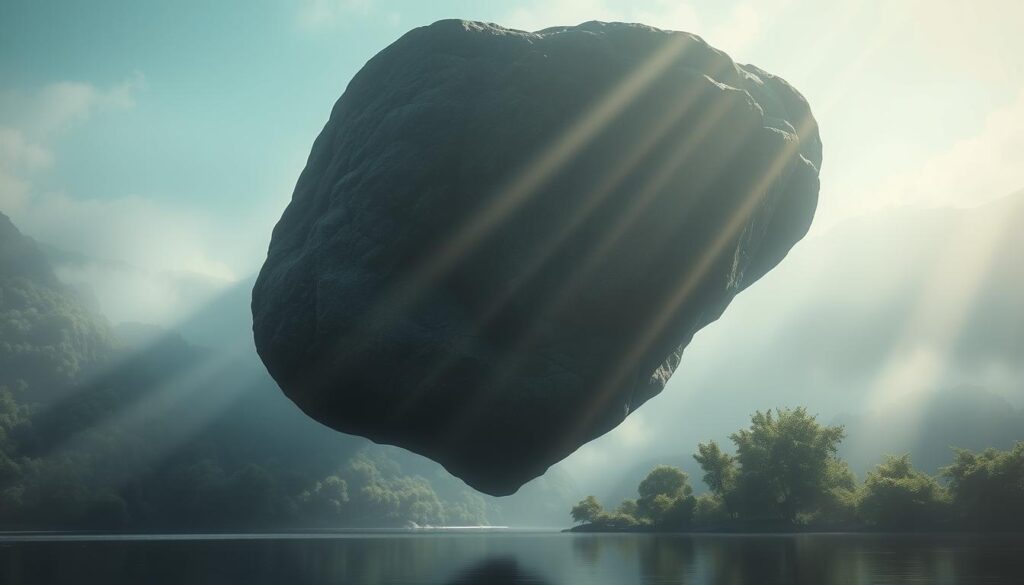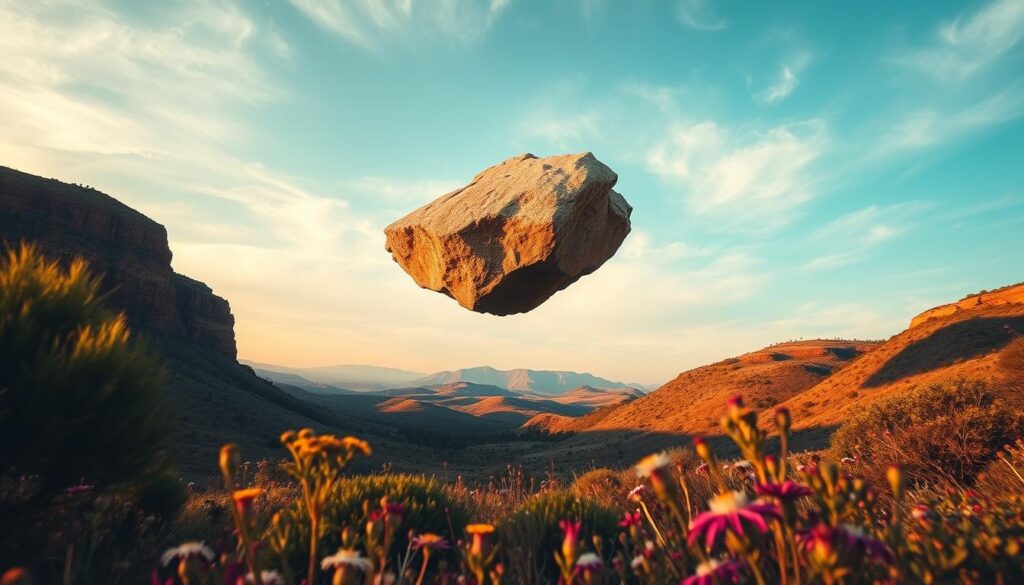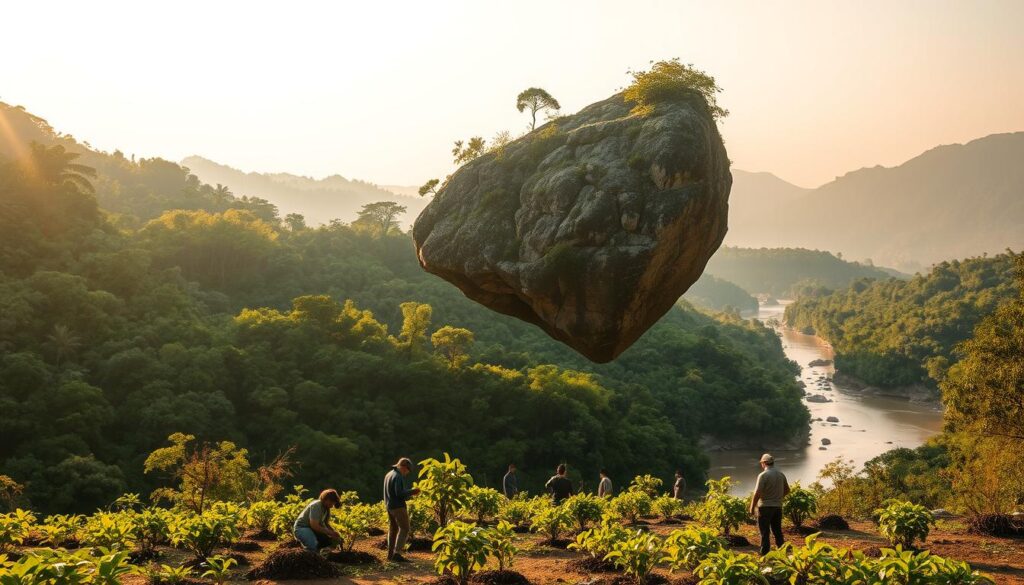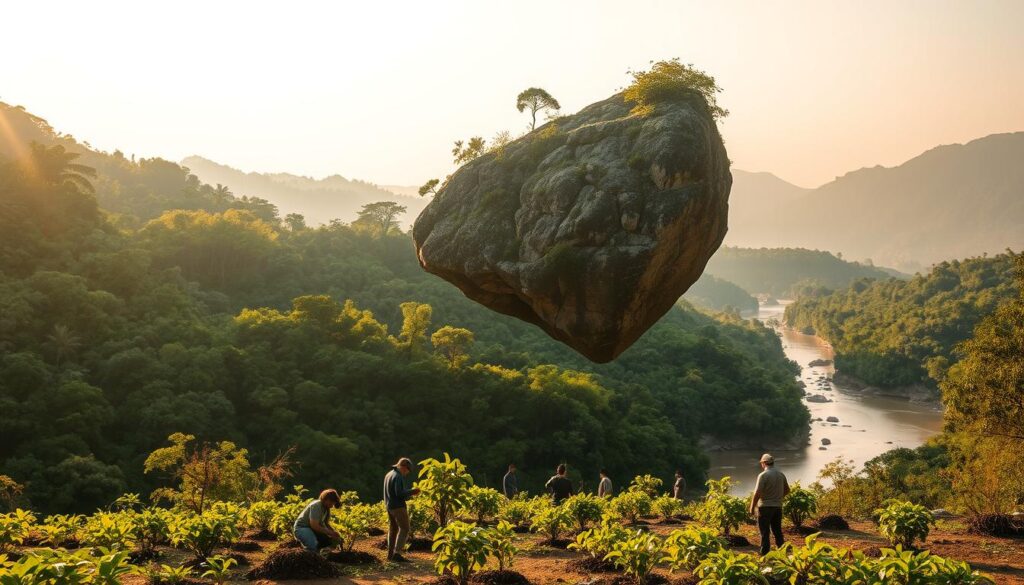Floating Rock in Mid Air, The floating rock in mid-air is a natural wonder that has caught the eye of people worldwide. It seems to defy gravity, leaving everyone in awe. This unique rock formation is a fascinating example of nature’s wonders.

Seeing the floating rock is an extraordinary experience. It’s a popular spot for those who love to explore the unknown. This article will explore its history, science, and cultural importance.
Introduction to the Floating Rock
If you love nature, science, or just the unknown, you’ll find this article interesting. The floating rock is a natural marvel that will amaze and inspire you.
Key Takeaways Floating Rock in Mid Air
- The floating rock is a natural wonder that defies gravity
- It is a unique geological phenomenon that sparks curiosity and fascination
- The floating rock is a popular destination for nature enthusiasts and science buffs
- It offers a glimpse into the complex processes that shape our planet
- The floating rock is a true marvel of nature that inspires awe and wonder
- Its geological phenomenon is a remarkable example of the natural world’s complexity
The Mysterious Phenomenon of the Floating Rock
The floating rock in mid-air has fascinated people for centuries. The first sightings were in ancient times. As news spread, scientists and researchers rushed to study it.
Many were amazed, but some doubted its existence. This mix of reactions made the floating rock a topic of interest.
Today, the floating rock is a top tourist attraction. People from everywhere come to see it. They hope to learn the scientific explanation for its levitation. Yet, the reason behind it remains a mystery.
Some key facts about the floating rock are:
- Location: It’s in a remote area, only reachable by foot or air.
- Size: The rock is about 10 feet wide and weighs tons.
- Duration: It has floated for centuries, never falling or moving.
First Discoveries and Documentation
The first recorded sighting of the floating rock was in ancient times. Early records show it was sacred to local tribes.
Scientific Observations
Scientists have studied the floating rock with advanced tech. They’ve looked at its composition and behavior. Some think it defies gravity, while others believe an unknown force holds it up.
Public Reaction and Media Coverage
The media has covered the floating rock a lot. Articles, documentaries, and videos have shown its beauty. People’s reactions vary, from wonder to doubt.
Understanding the Physics Behind the Floating Rock in Mid-Air
The floating rock in mid-air has a scientific explanation that’s quite interesting. It’s because of a rare mineral in the rock and the air around it. This mineral lets the rock handle huge pressure and weight. Meanwhile, the air is dense enough to make the rock float.
Scientists find this geological phenomenon really captivating. They’ve been studying it to figure out the physics behind it. The rock’s shape and size are key to its floating ability. They help it spread out its weight and stay balanced.
Several factors help the rock float:
- Density of the surrounding air
- Composition of the rock
- Shape and size of the rock
By looking into these factors, we learn more about the scientific explanation for the floating rock. Studying this geological phenomenon also helps us understand Earth’s history and how unique landforms form.
Location and Geographical Features
The floating rock is in a remote spot, surrounded by beautiful hills and dense forests. It’s a hit with tourists. You can get there by hiking trails or scenic roads, perfect for nature fans and adventurers.
The area’s high altitude and low humidity help the rock float. Conservation efforts are underway to keep this wonder safe for the future.
Here are some highlights of the area:
- Towering trees offer shade and shelter for local animals.
- Sparkling streams flow through, creating a calming sound.
- Many birds, insects, and small mammals live here.
The floating rock’s location and features make it a special place. It draws visitors worldwide with its natural beauty and mystery.
The Geological Formation Process
The floating rock in mid-air was formed through a complex process. It involves tectonic forces, weathering, and erosion. These forces worked together over millions of years to shape the rock.
The rock started as magma deep in the earth. As it cooled and solidified, it became a rock. Then, wind, water, and ice wore it down, changing its shape.
Key factors in the rock’s formation include:
- Tectonic forces: The earth’s crust moved, lifting the rock.
- Weathering: Wind, water, and ice wore it down.
- Erosion: Water and wind carved out its shape.
This natural wonder shows the power of geological forces. The floating rock is a marvel that has shaped our planet. It continues to amaze and inspire people everywhere.
Historical Significance and Cultural Impact
The floating rock in mid-air holds a special place in history and culture. It has deeply influenced the local community and beyond. This wonder has become a key part of the area’s identity, drawing visitors worldwide as a unique cultural significance and tourist attraction.
Local legends and folklore surround the floating rock. Many stories and myths tell of its origins and meaning. These tales have been shared for generations, making the rock even more fascinating. Scientists have also been studying it for years, trying to understand its nature.
Local Legends and Folklore
- Stories of ancient civilizations and their connection to the floating rock
- Myths about the rock’s origins and its supposed mystical powers
- Folklore about the rock’s impact on the local community and environment
Scientific Research Timeline
Scientists have been studying the floating rock for decades. They aim to understand its cultural significance and tourist attraction value. Their research has revealed the rock’s unique properties and its role in the local ecosystem.
Modern Cultural References
The floating rock has become a cultural icon. It has appeared in films, literature, and art. Its unique look and mystique have inspired many creative works, solidifying its role in modern culture as a significant cultural significance and tourist attraction.
Best Times to Visit and View the Phenomenon
The floating rock in mid-air is a captivating tourist attraction that can be visited all year. The best views are in spring and summer when the weather is clear and sunny. For photography enthusiasts, the early morning and late afternoon are perfect. The light is soft and golden during these times.
Visitors can plan their trip based on the season, considering the weather and the time of day. Here are some tips to make the most of your visit:
- Visit during the week to avoid crowds of tourists
- Avoid visiting during peak summer hours when the sun is high
- Bring a camera to capture the stunning views and apply photography tips to get the best shots

The floating rock is a unique and fascinating sight. With the right photography tips, you can capture its beauty and essence. Whether you’re a seasoned photographer or just a tourist attraction enthusiast, this phenomenon is sure to leave you in awe.
Photography Tips and Viewing Angles
Capturing the essence of a popular tourist attraction like the floating rock needs skill, patience, and the right gear. Photographers should have a good camera, lens, and tripod for stunning photos. The aim is to freeze the moment and show the beauty of the floating rock.
To get this right, consider these key points:
- Camera settings: use a wide aperture and fast shutter speed to capture the rock’s texture and movement.
- Prime photo locations: find designated viewing areas or hills for a clear view of the rock. It’s perfect for photography lovers.
For photography tips, knowing the lighting is key. The golden hour is best for capturing the floating rock. The soft, warm light makes the rock’s texture pop and creates a stunning scene. By following these tips and paying attention to the surroundings, photographers can take amazing photos of this unique tourist attraction.
Conservation Efforts and Environmental Protection
The floating rock in mid-air is a unique and fragile ecosystem. It needs careful conservation efforts and environmental protection. Authorities have set up laws and regulations to protect it. Visitors are asked to respect the environment and follow the rules.
Visitors should stay on designated trails, not litter, and not touch or damage the rock or its surroundings. By doing this, they help minimize their impact on the environment. This ensures the floating rock can be preserved for a long time.
Several organizations are also working to protect the floating rock and its surroundings. They promote environmental protection and raise awareness about preserving this unique ecosystem.
Here are some ways to get involved in conservation efforts:
- Supporting organizations that work to protect the environment
- Volunteering for clean-up initiatives and conservation projects
- Spreading awareness about the importance of environmental protection

By working together, we can protect the floating rock and its surroundings. This ensures the long-term preservation of this unique and fascinating natural wonder.
Similar Geological Phenomena Worldwide
The floating rock in mid-air is not alone. Around the world, there are many similar formations. Each one has its own special features and draws people’s attention.
These natural wonders have sparked scientific interest and public wonder. The floating rock is rare, but it has made people curious about other formations.
Some formations look like the floating rock. They have unique shapes and sizes. They can even hold up against huge weights.
For example, the balancing rocks in different places show the Earth’s incredible forces. These rocks sit on top of each other, showing the power of nature.
- Rock formations that defy gravity, such as the balancing rocks in the United States
- Unique landforms, like the towering sandstone pillars in Australia
- Natural wonders, such as the Grand Canyon, which is a prime example of erosion and geological forces at work
These formations are not just beautiful. They also tell us about the Earth’s past and how it changes. Each one has its own story, inspiring science and wonder.
Safety Guidelines and Visitor Protocols
The floating rock in mid-air is a top tourist attraction. Visitors must follow strict safety guidelines for their safety and the site’s preservation. Authorities have set rules to protect everyone and the environment.
Important safety guidelines include staying on trails, not touching the rock or its area, and not littering. Visitors should also respect the natural environment and wildlife.
To have a safe and fun visit, follow these tips:
- Stay on marked trails and avoid restricted areas
- Keep a safe distance from the rock and avoid touching or climbing on it
- Do not litter or dispose of waste improperly
- Respect the natural environment and wildlife
By following these safety guidelines and protocols, visitors help keep the floating rock and its surroundings safe for the future. It’s crucial to prioritize safety and the environment as a unique tourist attraction.
Conclusion: The Enduring Mystery of Nature’s Levitation
As we end our look at the floating rock, we’re amazed by its natural wonder. This geological phenomenon fascinates people everywhere. It shows us the endless mysteries in our world.
The floating rock shows our planet’s incredible power and creativity. It makes us think differently and sparks our curiosity. People come from all over to see it, hoping to understand how it stays aloft.
Our exploration has made us appreciate the natural world more. The floating rock reminds us that science is always learning. There’s always more to discover about our surroundings.
Let’s keep exploring and protecting these natural wonders. The floating rock’s magic will keep inspiring us. It shows us the endless wonders our world has to offer.
FAQ
What is the unique geological formation of the floating rock in mid-air?
The floating rock in mid-air is a natural wonder that seems to defy gravity. It’s made of a rare mineral that can handle huge pressure and weight. The air around it helps it stay aloft.
How did the floating rock form and what are the key factors contributing to its ability to float?
The rock formed through a mix of tectonic forces, weathering, and erosion over millions of years. Its shape, size, and the air around it are key to its floating ability.
What is the historical and cultural significance of the floating rock?
The floating rock holds deep cultural and historical value. It’s surrounded by legends and folklore. It’s also a symbol in art, literature, and media, inspiring wonder and curiosity.
When is the best time to visit and view the floating rock phenomenon?
Spring and summer are the best times to see the rock. The weather is clear, and the light is perfect for photos. Early morning and late afternoon are the best times to capture its beauty.
What are the safety guidelines and visitor protocols for the floating rock site?
To protect the rock and its environment, visitors must follow safety guidelines. Stay on trails, don’t touch the rock, and follow authority rules.
Are there similar geological phenomena like the floating rock found elsewhere in the world?
Yes, there are other unique geological formations around the world. They share some traits with the floating rock but each has its own special features.
Table of Contents
Source link
